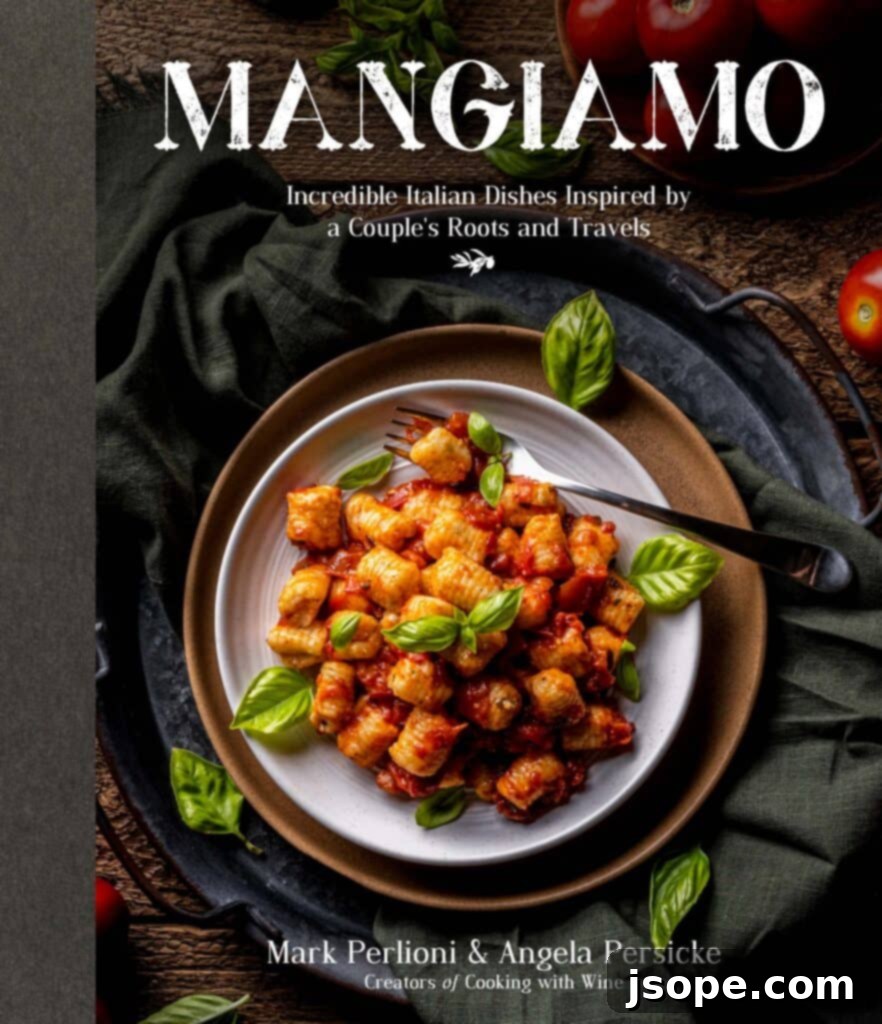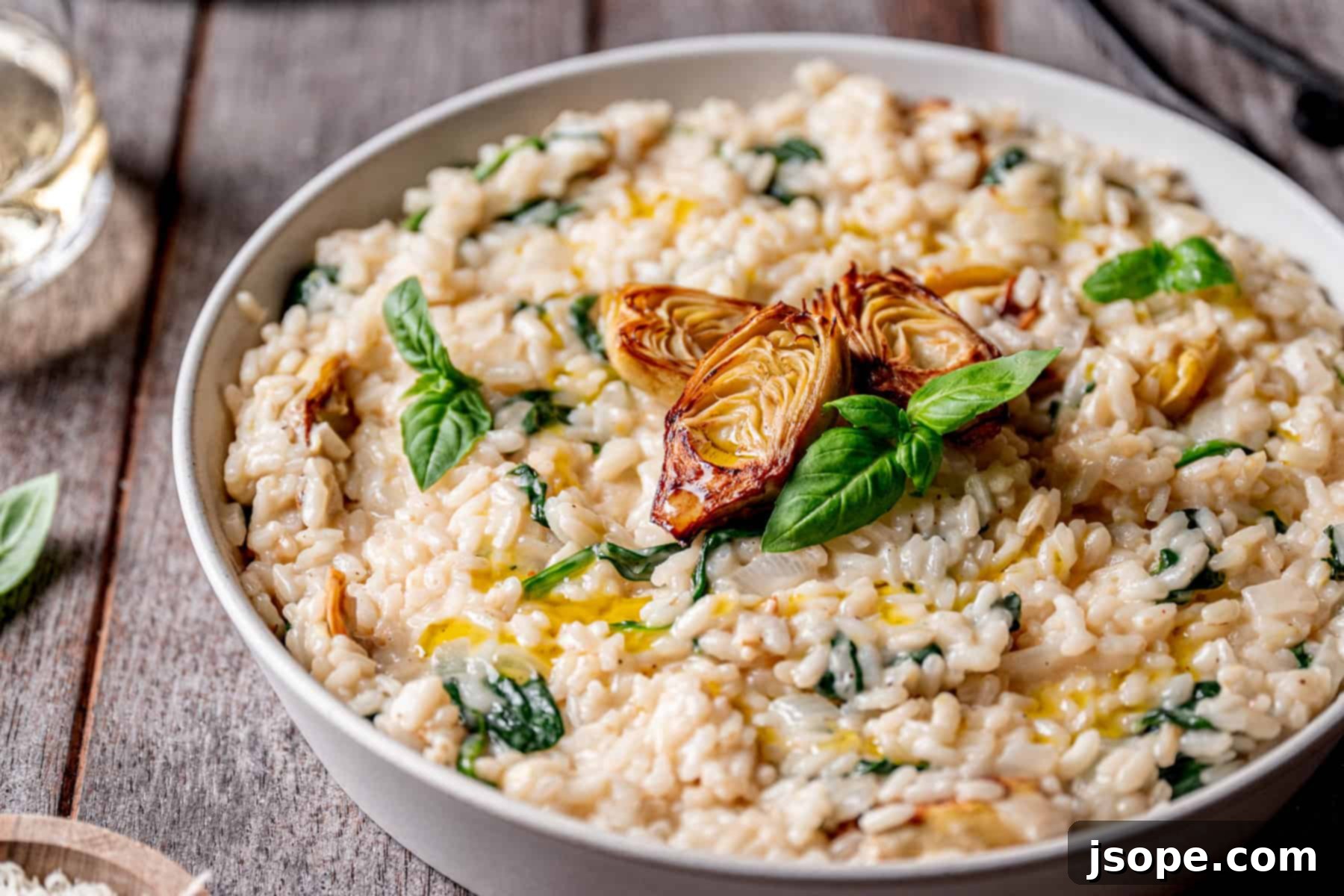Creamy Spinach Artichoke Risotto with Mascarpone: A Luxurious Italian Delight
Delight in the rich and comforting flavors of Italy with our exquisite Creamy Spinach Artichoke Risotto with Mascarpone Cheese. Risotto, a celebrated Italian rice dish, offers an incredible canvas for a myriad of tastes and textures. This particular recipe elevates the classic by combining the earthy goodness of fresh spinach and the tangy bite of artichoke hearts, all brought together with the luscious, velvety embrace of mascarpone cheese.
Unlike many traditional risottos, our version takes creaminess to an unparalleled level, thanks to the subtle yet impactful addition of mascarpone. This Italian dairy delight not only enhances the texture, making each spoonful melt in your mouth, but also introduces a delicate sweetness that perfectly complements the savory notes of spinach and artichoke. Whether you’re seeking a hearty and satisfying main course for a special occasion or a sophisticated side dish to accompany your favorite grilled meats or fish, this Spinach Artichoke Risotto promises to be a memorable culinary experience.
It’s a dish that embodies both rustic charm and elegant simplicity, proving that gourmet flavors can be achieved in your home kitchen without unnecessary complexity. Prepare to impress your family and friends with this vibrant, flavorful, and incredibly creamy risotto that stands out from the crowd.

If you enjoy experimenting with different risotto creations, explore our other beloved recipes such as the vibrant Cherry Tomato Garlic Basil Risotto or the deeply flavored Red Wine Parmesan Risotto.
Why You’ll Adore This Creamy Risotto Recipe
This Spinach Artichoke Risotto isn’t just another meal; it’s an experience waiting to unfold in your kitchen. Here’s why this recipe will quickly become a cherished favorite:
- Surprisingly Simple to Master: Despite its gourmet reputation, making risotto is far from daunting. Our step-by-step guide breaks down the process, making it accessible and genuinely enjoyable, even for novice cooks. The rhythmic stirring of the rice as it absorbs the stock is almost meditative, leading to a truly rewarding culinary creation.
- Fantastic for Leftovers & Arancini: While this risotto is irresistible fresh off the stove, any remaining portions are a treasure. Beyond simply reheating, leftover risotto is the foundation for an even more exciting dish: homemade arancini. These crispy, fried rice balls are a beloved Sicilian street food, offering a delightful second life for your risotto.
- Perfect for Any Season: With its vibrant flavors and comforting warmth, this risotto is incredibly versatile. It’s an ideal dish for a fresh spring gathering, a cozy autumn evening, or a delightful winter dinner. The combination of bright spinach and tender artichokes ensures it feels appropriate year-round.
- Elegant Yet Approachable: Impress guests with a dish that looks sophisticated and tastes luxurious, without requiring hours of complicated techniques. Risotto offers a rustic elegance that speaks volumes about your culinary prowess, even when it’s remarkably straightforward to prepare.
- Ultimate Comfort Food: Few dishes provide the soul-satisfying warmth and creamy indulgence of a perfectly prepared risotto. This Spinach Artichoke Risotto, enriched with mascarpone, wraps you in a hug of flavor, making it the quintessential comfort food for any day.
The Rich History and Origins of Risotto in Italy
The journey of rice to the Italian peninsula dates back to 14 BC, introduced by Arab traders who brought this versatile grain to the region. However, the risotto we know and love today truly began to take shape in the early 1800s, with the first written recipes for modern risotto appearing around this time. Risotto is most famously associated with the culinary traditions of Northern Italy, where its creamy texture and rich flavors are celebrated. Cities like Milan, Genoa, Venice, and Verona are renowned for their unique variations of this beloved dish.
The secret to authentic risotto lies in the type of rice used and the cooking technique. Italian risotto rice is typically a short to medium-grain variety, specifically chosen for its high starch content. Crucially, this rice is never rinsed before cooking. This is because the surface starch, which would be washed away by rinsing, is essential for creating risotto’s characteristic creamy consistency. As the rice grains gently rub against each other during the constant stirring, this starch is released, forming a luxurious, velvety sauce that envelops each grain. Understanding this fundamental principle is key to achieving a truly exceptional risotto.
For those interested in a more classic rendition, our Saffron Risotto offers a taste of traditional Milanese style.
Choosing the Perfect Rice for Your Risotto
The type of rice you select is paramount to the success of your risotto. For an authentic Italian experience, we highly recommend using Carnaroli Rice, Vialone Nano Rice, or Arborio Rice. Each variety boasts distinct characteristics that contribute to the final dish:
- Carnaroli Rice: Often hailed as the “king of risotto rice,” Carnaroli is our top preference. It’s a superfine, medium-grain rice known for its excellent ability to absorb liquids and flavors while maintaining a firm, separate texture (al dente). Its higher starch content leads to an exceptionally creamy risotto, and it’s more forgiving during cooking, making it a favorite among chefs.
- Vialone Nano Rice: A medium-grain rice from the Veneto region, Vialone Nano is another superb choice. It has a slightly rounder, plumper grain than Carnaroli and is celebrated for its delicate flavor and ability to create a very creamy risotto without becoming sticky. It cooks a bit faster than Carnaroli and is often preferred for seafood risottos.
- Arborio Rice: This is generally the most common and easiest to find risotto rice in US grocery stores. Arborio rice is a short-grain rice with a high starch content, yielding a very creamy texture. While delicious, it tends to release its starch more quickly and can sometimes become mushy if overcooked, so careful attention is required.
Regardless of your choice, remember the golden rule: never rinse your risotto rice! The starches on the grain’s surface are crucial for that signature creamy consistency.

Essential Ingredients for Your Creamy Spinach Artichoke Risotto
Crafting this delightful risotto requires a selection of fresh, high-quality ingredients, each playing a vital role in building the dish’s complex and harmonious flavor profile:
- Artichokes: Canned small artichoke hearts are incredibly convenient and perfect for this recipe. Their delicate, slightly tangy flavor provides a wonderful counterpoint to the richness of the cheese and spinach.
- Kosher Salt: An essential seasoning used throughout the cooking process to enhance and balance all the flavors, from searing the artichokes to finishing the risotto.
- Olive Oil: A touch of olive oil is used to sear the artichoke hearts, developing their flavor and texture. A drizzle of extra virgin olive oil for garnish at the end adds a fresh, peppery note.
- Vegetable Stock: This forms the liquid base of our risotto, imparting a subtle yet deep layer of savory flavor while keeping the dish entirely vegetarian. Ensure it’s warm before adding to the rice for optimal absorption.
- Unsalted Butter: Butter is a cornerstone of risotto, used to sauté the onion and toast the rice, building a rich foundation. A final swirl of butter at the end adds an irresistible glossy finish and luxurious mouthfeel.
- Yellow Onion: Finely diced yellow onion forms the aromatic base, or soffritto, of most classic risotto recipes. Sautéed until translucent, it provides a gentle sweetness and depth without overpowering other ingredients.
- Risotto Rice: As discussed, we prefer Carnaroli for its starchiness and texture retention, but Vialone Nano or Arborio rice will also yield excellent results, contributing to the dish’s signature creaminess.
- Dry White Wine: A splash of dry white wine is a traditional addition to risotto. It deglazes the pan, adds a lovely layer of acidity, and introduces a subtle, complex flavor that brightens the overall profile. Pinot Grigio is an excellent choice.
- Fresh Spinach: Baby spinach leaves are incorporated at the very end, wilting quickly to add a vibrant green color, a delicate earthy flavor, and a boost of nutrients to the dish.
- Parmesan Cheese: Freshly grated Parmigiano Reggiano is crucial for that elevated, sophisticated, and distinctly Italian flavor. Its salty, umami notes blend beautifully into the creamy rice. Avoid pre-grated varieties for best results.
- Mascarpone Cheese: This non-traditional yet inspired addition is our secret weapon for unparalleled creaminess and a slightly sweet, rich flavor. It melts seamlessly into the risotto, enhancing its luxurious texture.
- Black Pepper: A fresh pinch of black pepper at the end adds a subtle warmth and aromatic complexity, tying all the flavors together.
- Lemon Zest: The finely grated zest of a fresh lemon provides a bright, aromatic lift that complements the artichokes and cuts through the richness of the cheese, offering a nuanced citrus note without the tartness of lemon juice.
Please refer to the recipe card below for precise quantities.
Thoughtful Substitutions for Your Risotto
While the original recipe offers a perfect balance of flavors, culinary creativity often calls for adaptability. Here are a few common and effective substitutions you can make:
- Rice: If Carnaroli isn’t available, Vialone Nano or Arborio rice are excellent alternatives that will still yield a wonderfully creamy risotto.
- Artichokes: Feel free to use frozen or fresh artichoke hearts instead of canned. If using fresh, boil or steam them until tender before searing.
- Spinach: Baby kale can be a delightful substitute for spinach, offering a slightly more robust, earthy flavor and similar nutrient benefits.
- Stock: While vegetable stock keeps this dish vegetarian, chicken stock can be used as a flavorful alternative if preferred, adding a deeper savory note.

Mastering the Art of Spinach Artichoke Risotto
Making risotto often carries an undeserved reputation for being a difficult and laborious task. We’re here to debunk that myth! Bringing this comforting and elegant dish together is surprisingly straightforward and incredibly rewarding. The key lies in understanding a few fundamental techniques and patiently layering flavors.
For this delightful Spinach Artichoke Risotto, the process begins with preparing the artichokes. Small, halved artichoke hearts are briefly seared in olive oil until they develop a lovely golden-brown crust, intensifying their flavor before being set aside. The true foundation of the risotto starts with sautéing diced onion in butter until translucent, creating a sweet and aromatic base. Next, the risotto rice is added to the pan, where it’s gently “toasted” in the butter, allowing the grains to absorb initial flavors and preventing them from becoming mushy later. A splash of dry white wine is then introduced, providing essential acidity and deepening the flavor profile as it’s fully absorbed by the rice.
The heart of risotto cooking involves gradually adding warm vegetable stock, one ladleful at a time, while continuously stirring. This rhythmic process encourages the rice to slowly release its starches, creating that signature creamy texture without requiring any actual cream (though our mascarpone takes it even further!). As the rice nears perfection – tender with a slight bite (al dente) – fresh spinach is stirred in, wilting gracefully. Finally, the mascarpone and a finishing touch of butter and grated Parmesan cheese are folded in, enriching the risotto with unparalleled creaminess and savory depth. A final flourish of lemon zest and the seared artichokes completes this exquisite dish. It’s a delicious, satisfying meal that truly doesn’t take forever to achieve gourmet results!
Essential Equipment for Crafting Creamy Risotto
To successfully create this luscious risotto dish, you’ll need a few basic kitchen tools:
- A small frying pan: Ideal for searing the artichokes to perfection.
- A large sauté pan or braiser: The main vessel for cooking your risotto, allowing enough surface area for even cooking and stirring.
- A smaller pot: Essential for keeping your vegetable stock warm, which is crucial for the risotto’s texture.
- A zester or microplane: For finely zesting the lemon, ensuring its bright aroma is evenly distributed without any bitterness.

Step-by-Step Instructions: Crafting Your Spinach Artichoke Risotto
Step 1: Prepare and Sear the Artichokes
- Begin by draining the canned artichoke hearts thoroughly and halving them lengthwise. Pat them very dry with paper towels; this step is crucial for achieving a good sear. Lightly sprinkle the artichokes with a pinch of kosher salt. Heat 2-3 tablespoons of olive oil in your small frying pan over medium-high heat. Once hot, add the halved artichokes and cook them on each side for a few minutes until they begin to brown and caramelize beautifully. Remove the seared artichokes to a paper towel-lined plate to drain any excess oil and set them aside.
Step 2: Build the Risotto Foundation
- In a small pot, gently heat the vegetable stock over medium-low heat until it’s steaming, then reduce it to a gentle simmer on low. It’s essential to keep the stock warm throughout the cooking process. Meanwhile, in your large sauté pan or braiser, add 3 tablespoons of unsalted butter over medium heat. Once the butter has melted and is shimmering, add the finely diced yellow onion. Cook the onion, stirring occasionally, until it becomes translucent and tender but without browning, about 5-7 minutes. Add the risotto rice to the pan and stir constantly for 1-2 minutes to “toast” the rice grains. This helps them absorb flavors and cook evenly. Pour in the dry white wine and stir continuously until the wine is completely absorbed by the rice, leaving no liquid in the pan.
Step 3: Gradually Cook the Rice to Perfection
- Now, begin the gradual incorporation of the warm vegetable stock. Add 1 to 2 ladles of stock to the rice, stirring constantly. The rice will slowly absorb the liquid. Once the stock is almost fully absorbed and the rice is no longer swimming in liquid, add another ladle or two of stock, continuing to stir frequently. Repeat this process, adding stock ladle by ladle, until the rice is tender but still retains a slight bite (al dente). This stage typically takes about 18-20 minutes. As the risotto nears completion, you’ll notice it becoming progressively creamy. For the very last addition, add one more ladle of stock.
Step 4: Finish and Serve the Risotto
- With the final ladle of stock added and still stirring, incorporate the baby spinach leaves. Continue stirring gently; the spinach should wilt completely into the risotto within about a minute. Turn off the heat. Stir in the mascarpone cheese and the last tablespoon of unsalted butter until both are fully melted and incorporated, creating an extra layer of richness and creaminess. Next, stir in the grated Parmesan cheese until it’s well combined. Taste the risotto for seasoning and add a pinch of black pepper, and additional kosher salt if necessary, to taste. Finally, gently fold in the fresh lemon zest and the earlier seared artichokes. Serve your creamy Spinach Artichoke Risotto immediately, garnished with fresh basil leaves, a drizzle of good extra virgin olive oil, or a sprinkle of extra Parmesan cheese. Enjoy!

Creative Variations for Your Risotto
Once you’ve mastered this delicious Spinach Artichoke Risotto, feel free to get creative with these inspiring variations:
- Asparagus and Orange Zest Risotto: For a completely different seasonal twist, replace the artichokes with fresh asparagus spears (blanched and chopped) and swap the lemon zest for aromatic orange zest. This creates a bright, subtly sweet, and wonderfully fresh risotto.
- Add Protein: To make this dish a more substantial main course, consider adding a protein. Small pieces of grilled chicken or sautéed shrimp can be folded in during the final stages of cooking, providing a hearty complement to the creamy rice.
- Mushroom Medley: Sauté a mix of your favorite mushrooms (cremini, shiitake, or wild mushrooms) with the onion for an earthy, umami-rich variation.
- Spicy Kick: Introduce a pinch of red pepper flakes with the onion for a subtle warmth, or more for a bolder, spicy flavor.
Storing Your Leftover Risotto
Proper storage is key to enjoying your risotto beyond its initial serving:
- How to store leftover risotto: Transfer any cooled leftover risotto into an airtight container and store it in the refrigerator. It will maintain its quality and flavor for up to 5 days.
How to reheat leftover risotto:
- The best method for reheating risotto is gently in a pan over low heat. As risotto tends to firm up when chilled, it will likely be necessary to add a splash of warm vegetable stock, water, or even a little white wine to loosen it up and help regain some creaminess. While it won’t be quite as creamy as when it was freshly made, it will still taste wonderfully flavorful. Stir continuously until heated through.
Can you freeze leftover risotto?
- Yes, this risotto freezes quite well. While the texture may not be as perfectly al dente upon thawing and reheating, the rich flavors will be preserved. Ensure the risotto is completely cooled before transferring it to an airtight, freezer-safe container. It can be stored in the freezer for 3-4 months. Thaw overnight in the refrigerator before reheating.

Transforming Leftover Risotto into New Delights
Leftover risotto is a culinary gift, offering an exciting opportunity to create an entirely new dish. The most celebrated and popular use for leftover risotto is making Arancini.
Arancini are delightful Sicilian fried rice balls, and they are incredibly simple to prepare. Start by shaping your cooled leftover risotto into small balls. For an extra treat, you can tuck a small cube of mozzarella or another favorite cheese into the center of each ball. Once shaped, these risotto balls are then breaded (typically in flour, egg, and breadcrumbs) and deep-fried until golden brown and crispy. The result is a warm, gooey center encased in a perfectly crunchy exterior. Arancini are a hugely popular street food in Sicily and have gained widespread popularity, now found in many Italian restaurants and food markets worldwide. Beyond arancini, you could also flatten chilled risotto into patties and pan-fry them for quick and savory risotto cakes.
Chef’s Top Tip for Perfect Risotto
Here’s a crucial piece of advice that will make all the difference in your risotto: NEVER rinse the rice used for risotto! The surface starch on these specific Italian rice grains is the magical ingredient that, when released through stirring, creates the signature creamy, velvety texture that defines a truly exceptional risotto. Rinsing would wash away this essential starch, leaving you with a less-than-creamy result.
Risotto Troubleshooting Tips
Even seasoned cooks can encounter small hiccups in the kitchen. If, for any reason, you find yourself running low on vegetable stock towards the end of cooking and need just one more ladle or so to achieve the perfect al dente texture, don’t panic! Simply use hot water as a substitute. It will work perfectly fine to finish cooking the rice without significantly altering the flavor profile.
Perfect Pairings: What to Serve with Your Risotto
This creamy Spinach Artichoke Risotto is wonderfully versatile. It is hearty and flavorful enough to stand beautifully on its own as a vegetarian main course. However, it also makes an exquisite side dish when paired with a variety of grilled or pan-seared proteins. Consider serving it alongside a perfectly cooked pork chop, a tender veal chop, succulent roasted or pan-seared chicken, or delicate flaky fish. The richness of the risotto complements these proteins beautifully, creating a balanced and satisfying meal.
Selecting the Perfect Wine to Complement Your Risotto
Pairing the right wine can truly elevate your dining experience. For this creamy Spinach Artichoke Risotto, white wines are generally the best choice, offering a crisp counterpoint to its richness. Here are our top three recommendations:
- Pinot Grigio: A classic Italian pairing, Pinot Grigio offers a dry, crisp, and refreshing profile with notes of green apple and citrus that beautifully cut through the creaminess of the risotto.
- Pinot Bianco: Also known as Weissburgunder, Pinot Bianco provides a slightly richer, more full-bodied experience than Pinot Grigio, with delicate almond and apple notes that harmonize well with the artichoke and mascarpone.
- Chardonnay (Italian): Opt for an unoaked or lightly oaked Italian Chardonnay. These typically offer bright acidity and mineral notes, with less overt oakiness than their New World counterparts, making them a sophisticated match.
A nice, dry rosé wine will also pair excellently with this risotto, providing a delightful balance of fruit and acidity. Remember, the key is to choose a dry wine to avoid clashing with the savory elements of the dish.

Explore More Italian Delights with Our Cookbook: Mangiamo
Continue your culinary journey through Italy with our cherished cookbook, Mangiamo. This beautiful collection features 60 authentic Italian recipes, each inspired by our deep Italian roots and extensive travels across the country. Filled with drool-worthy images and easy-to-follow instructions, Mangiamo invites you to bring the heart of Italy into your own kitchen.
Frequently Asked Questions About Risotto
When cooking risotto, the most important rule is to use a dry white wine, never a sweet one, as sweetness will negatively impact the savory flavor of the dish. Pinot Grigio is a fantastic and popular choice, but feel free to use any dry white wine you enjoy drinking. Sauvignon Blanc, Chardonnay (unoaked), or Vermentino are also excellent options.
Yes, risotto made with traditional Italian rice (like Arborio, Carnaroli, or Vialone Nano) is naturally gluten-free, as rice itself does not contain gluten. This particular Spinach Artichoke Risotto recipe is also entirely gluten-free, provided all other ingredients used (such as stock and cheese) are certified gluten-free.
Orzo and risotto, despite sometimes being confused, are fundamentally different. Orzo is a small, rice-shaped pasta made from semolina flour (wheat), cooked much like any other pasta. Risotto, on the other hand, is a specific Italian dish prepared with starchy short-grain rice, cooked slowly by adding liquid gradually to achieve a creamy consistency. They are not interchangeable in recipes.
More Delicious Recipes You Might Enjoy
If you’ve loved this creamy risotto, be sure to explore these other fantastic recipes:
- Pan Fried Risotto Cakes – Easy Leftover Risotto Recipe
- Spinach Artichoke Risotto with Creamy Mascarpone Cheese
- Milanese-Style Creamy Saffron Leek Risotto Recipe
- Brown Butter and Sage Polenta Recipe
Delightful Meat and Seafood Pairings for This Risotto
While our Spinach Artichoke Risotto is a complete meal on its own, it also serves as a phenomenal side dish to a variety of meat and seafood options. Here are some of our favorite main courses to serve alongside this rich and creamy risotto:
- Bone-In Veal Milanese Recipe (Cotoletta alla Milanese)
- Crispy Parmesan Crusted Baked Cod Recipe
- Chicken Piccata with Caper Lemon Butter Sauce
- Braised Veal Shanks with Gremolata (Ossobuco Recipe)
📖 Recipe: Spinach Artichoke Risotto with Creamy Mascarpone Cheese

Spinach Artichoke Risotto with Creamy Mascarpone Cheese
Equipment
- Small frying pan for the artichokes
- large sauté pan or braiser to make the risotto
- smaller pot to warm the stock
- zester or microplane for zesting the lemon
Ingredients
- 1 can (14oz) baby artichokes drained and rinsed, halved lengthwise
- Pinch kosher salt
- 2-3 Tablespoons olive oil
- 6 cups vegetable stock low sodium
- 4 Tablespoons unsalted butter divided
- ¾ cup yellow onion small dice
- 2 cups rice for risotto Carnaroli, Vialone Nano, or Arborio
- ½ cup dry white wine
- 2 cups baby spinach leaves
- 1 cup grated parmesan cheese
- ½ cup mascarpone cheese
- Pinch black pepper
- 1 medium lemon zest only
Instructions
- Drain and halve the artichoke hearts. Dry them well with paper towels and sprinkle with a pinch of kosher salt. Heat the olive oil in a small frying pan over medium-high heat. Add the artichokes and cook on each side until they start to brown. Remove to a paper towel lined plate and set aside.1 can (14oz) baby artichokes, Pinch kosher salt, 2-3 Tablespoons olive oil
- Heat the vegetable stock over medium-low heat in the small pot then reduce to a gentle simmer on low. Meanwhile, in the large sauté pan or braiser, add 3 Tablespoons of the butter over medium heat. Once melted add the onion and cook until translucent and tender, but not browned. Add the rice and stir well to coat the rice and cook for 1-2 minutes to “toast” the rice. Add the wine and stir and cook until the wine is completely absorbed by the rice.6 cups vegetable stock, 4 Tablespoons unsalted butter, ¾ cup yellow onion, 2 cups rice for risotto, ½ cup dry white wine
- Start incorporating the stock by adding 1-2 ladles at a time while stirring the rice. Once almost absorbed, add another ladle or two of stock, stirring often. Continue until the rice is tender but not mushy and has a little bite (this should take about 18-20 minutes). Once almost done, add one more ladle of stock.
- With the last ladle of stock, add the spinach and stir. It should wilt completely in about a minute. Turn the heat off and then stir in the mascarpone and the last tablespoon of butter. Once they are incorporated, stir in the grated parmesan cheese. Taste for seasoning and add the pepper and a pinch of salt if necessary. Finally, fold in the lemon zest and seared artichokes. Serve and garnish with basil, olive oil or more parmesan.2 cups baby spinach leaves, 1 cup grated parmesan cheese, ½ cup mascarpone cheese, Pinch black pepper, 1 medium lemon zest
Notes
- Rice: Besides Carnaroli, you could use Vialone Nano or Arborio rice.
- Artichokes: Frozen or fresh artichokes are also an option here if desired.
- Spinach: You could also use baby kale here instead.
- Stock: Chicken stock can be used in place of vegetable stock if desired.
How to store leftover risotto:
- Store in an airtight container in the refrigerator for up to 5 days.
How to reheat leftover risotto:
- Gently in a pan is the best way over low heat. It might be necessary to add a bit of stock or water to loosen it up. Unfortunately, there is no way to make it as creamy as when you initially made it but it still tastes great leftover!
Can you freeze leftover risotto?
- This risotto freezes fine. The texture will not be as good but the flavor will be. Make sure the risotto is cooled before sealing and placing in the freezer. It will last for 3-4 months frozen.
Nutrition
We hope you thoroughly enjoy preparing and savoring this creamy Spinach Artichoke Risotto with Mascarpone Cheese. It’s a dish that truly brings the warmth and comfort of Italian cuisine into your home, perfect for sharing with loved ones or enjoying as a luxurious treat for yourself. Buon appetito!

